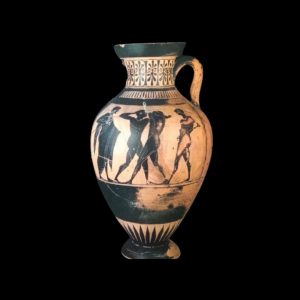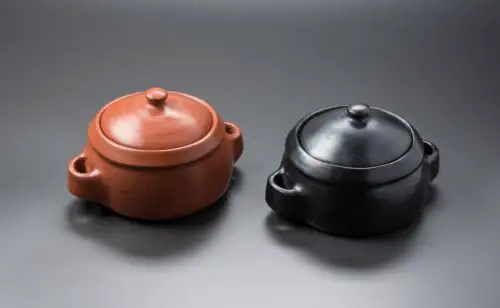Translated by Nick R
We are aware that if you are just starting out in the ceramic world, there will be some terms that you may not understand at all, and that will make you feel out of place. But keep calm! Today you will learn the best artisanal pottery glossary that will help you understand every process in this wonderful art.
Table of Contents
A
Agateware:
A decorative technique, also called Millefiore, which involves combining different colored clays in the same piece but without mixing them together.
Air-hardening clay:
Type of clay created specifically so that, after modeling, it can dry outdoors completely, so there is no need for a kiln to fire it.
Almagra:
Ancient decorative technique that consists of applying almagre, also known as iron oxide, to the piece to give it a reddish color.
B
Ball Clay:
Type of plastic clay that is very easy to handle. Its name comes from the form in which it was collected in the past since it is believed this clay was extracted as a ball or cube.
Bas-relief:
Decoration technique in which thick and deep strokes are made on the clay piece to create figures decorating the object.
Barbotine:
A transparent material (can be liquid) used in ceramics as a glue for raw or fired clay pieces. The barbotine is composed of several paste deflocculants including sodium silicate, sodium carbonate, tannin, sodium tannate, sodium pyrophosphate, and finally, water.
Bisque:
This is the name of a ceramic piece that has undergone a first firing or burning.
Boquique:
Ancient decorative technique in which various objects with points of different shapes are used to make small separated and intercalated strokes forming a decorative sequence.
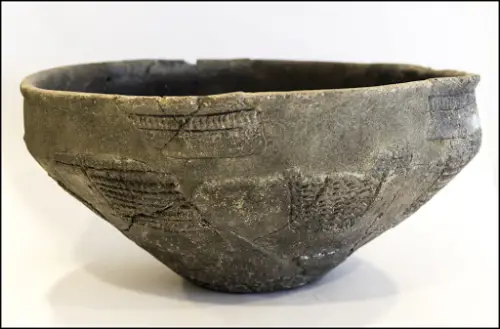
Taken from Thesaurus
Burning or firing:
Firing is the process by which clay modeled pieces are submitted to high temperatures caused by fire, these temperatures make the mass harden completely and stop being raw.
Brush:
An instrument used to apply substances such as varnish, makeup, paint, among others. For ceramics, there are various types of brushes to decorate them.
Brushing:
This technique consists of giving shine to a clay piece by rubbing it with Agate stones.
C
Calcite:
A sedimentary mineral material composed of calcium that works as a temper. It is widely used in the construction industry as its properties provide the necessary resistance to the pieces.
Cardial:
Ancient decorative technique in which typical sea shells are used to make small strokes to decorate the clay piece.
Casting:
It is a modeling technique based on using plaster molds to form a piece from liquid clay.
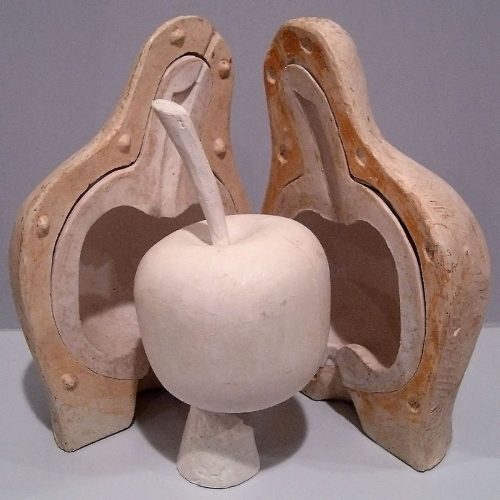
Taken from Wikipedia
Centering:
Is the process by which the potter makes sure to put the clay right in the center of the wheel It may sound easy, yet the centering of the mass is very important because the success of throwing depends on it.
Ceramics:
It is the technique, art, or discipline of making objects in different types of clay.
Ceramic decals:
They are decals with a variety of drawings and designs that you can place on your ceramic pieces to give them a unique touch.
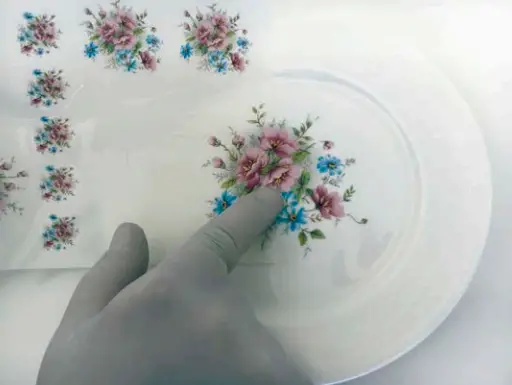
Taken from Marphil.
Ceramic glazes:
Ceramic glazes are a mixture of flux materials such as alkali metal, boron, and strontium, among others, with quartz which is applied to the ceramic using different glazing techniques before the second firing. Glazes are used to brighten the pieces, making them more resistant and waterproof.
Ceramic kiln:
Tool used to insert and fire the raw clay pieces at high temperatures. There are electric and gas ceramic kilns, which are the two most used by potters today. They are used to fire the pieces and make the ceramic glaze adhere.
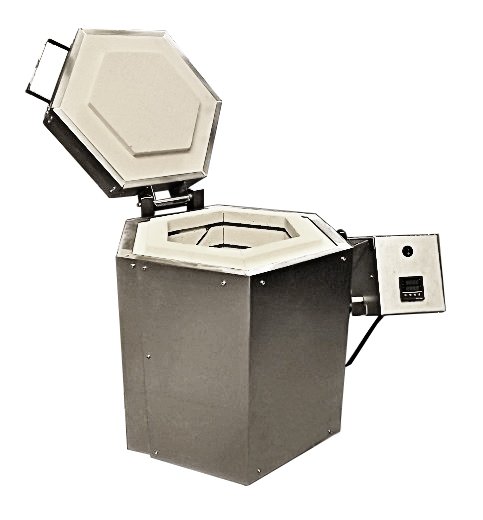
Taken from eBay
Ceramic pigments:
These are colorants used in glazes or applied directly on the clay when kneading it to give it color. They are made from calcined blends of coloring oxides such as iron and copper, and are sometimes accompanied by elements acting as color modifiers such as calcium and tin.
Ceramist:
Someone who is professionally involved in the manufacturing of ceramic objects.
Chamba ceramics:
Ceramic style is characterized by its black color. It takes its name from the place of origin: the village of La Chamba in Tolima, Colombia. Chamba pottery is one of the most recognized ceramics in the country.
Chamote:
Type of clay and temper also called grog. This clay comes from stones and is calcined, crushed or ground and added to highly plastic clays to increase their resistance.
Clay:
Clay is a fine soil composed of aluminum minerals that make it white when pure and colored when impure. This material is obtained from nature and processed to be used in pottery to elaborate different figures.
Clay slab roller:
A tool used to create clay slabs of a specific thickness and size. It is done by means of one or two rollers driven by rudders responsible for their movement and, therefore, for flattening the clay that goes through them.
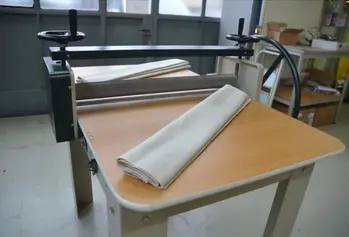
Taken from Hobbyland
Cold porcelain:
A type of clay made from vinyl glue, mineral oil, hand cream, cornstarch, glycerin, white vinegar, and fabric softener. Cold porcelain is very easy to use and dries quickly.
Contemporary pottery:
It is the evolution of traditional ceramics in conjunction with humanity, technology, and science. All pieces or objects in contemporary ceramics are characterized by having abstract shapes and designs.
Coil:
This is the name for a long strip of clay. The name refers to its resemblance to a coil. The coiling technique is based on using only these clay strips, and is one of the most common modeling techniques.
Combing:
Ancient decorative technique of dragging a comb over a piece in fresh clay to leave a series of strokes for decoration.
Cracking:
The appearance of cracks or strokes that create the impression that the piece may break along these lines.
Cutter:
This tool is composed of two parts: two wooden sticks and a nylon cord or steel wire joining them. Its function is to cut the clay quickly and easily. You only have to hold the sticks in your hands and pull them for the nylon to do the job of cutting the clay.
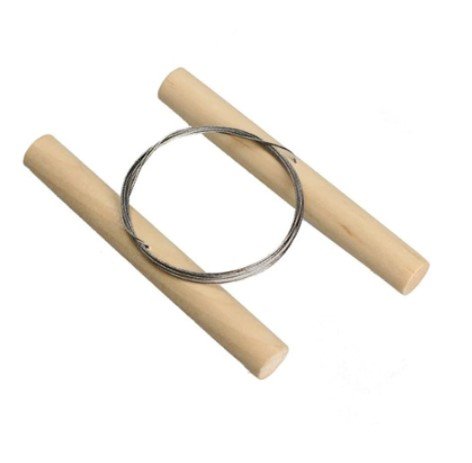
Taken from AliExpress
D
Dipping:
It is a technique for handling engobes that consists of dipping the whole piece into the engobe. It is necessary to have large amounts of engobe and pour it into a plastic container.
E
Easel:
Part of a potter’s wheel that works as a table where the potter can place items that they need to use and need to have close by.
Earthenware or wicker:
The oldest existing type of clay; this mass is one of the easiest to handle. Earthenware can hold liquids, but not much weight. Its intense white color is given by its high content of limestone: a sedimentary rock mostly composed of calcium.
Engobes:
Ceramic engobes are any materials made by mixing clays and water and whose main purpose is to decorate the ceramic pieces before they are fired. They serve mainly to paint ceramics or give them a smooth, glazed surface.
Excision:
Ancient decorative technique where a piece of dough is removed or cut from the clay piece to create a sinking easy to see to the naked eye to give a distinctive appearance to the piece.
Extruder:
This is a machine that works to create clay strips. They can be very thick, thin or intermediate, all depending on the extruder’s thickness or on the design discs. It is one of the most used machines in the ceramic world.
F
Feldspar:
Type of temperer in form of mineral stone composed of aluminum and silicon. This material is used to make plastic clays firmer.
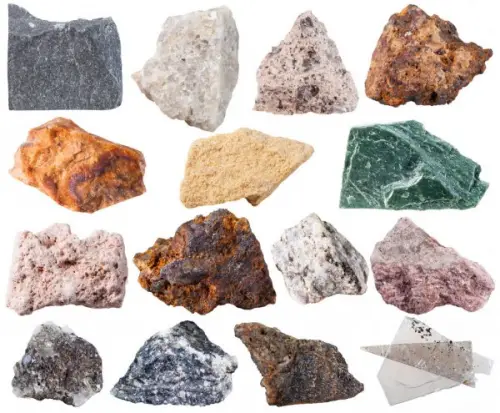
Taken from depositphotos
Finger or nail fingerprinting:
Ancient decorative technique consisting of pressing the finger or fingernail on the fresh clay piece to mark a sequence part of the decoration of the object.
Fuel materials:
In the world of ceramics, we refer as fuel materials to materials that come from nature and are used to decorate ceramics; these include, for example, paper, fruit seeds, straw or grass, etc.
Fired ceramic pieces
Kiln-fired pieces
Taken from 123RF by Aleksandr72
Frame:
Framework made of sticks used to fix canvases and fabrics for painting objects underneath these structures.
G
Glazing technique:
Decorative technique consisting of coating the ceramic with glaze to obtain a clearer and shinier finish, similar to glass, once fired. This technique can be applied to any type of clay, both high and low temperature.
Glazing:
It consists of applying ceramic glazes to pieces that have been fired in the kiln. Glazes make the piece more resistant, waterproof, and shiny, in addition to providing interesting effects and textures depending on the glaze you choose to apply.
Grooving:
Ancient decorative technique in which a round-pointed tool is used to make grooves to decorate the clay piece.
I
Incising:
Ancient decorative technique by which one or more pointed objects are used to draw strokes in different shapes that get engraved on the clay piece.
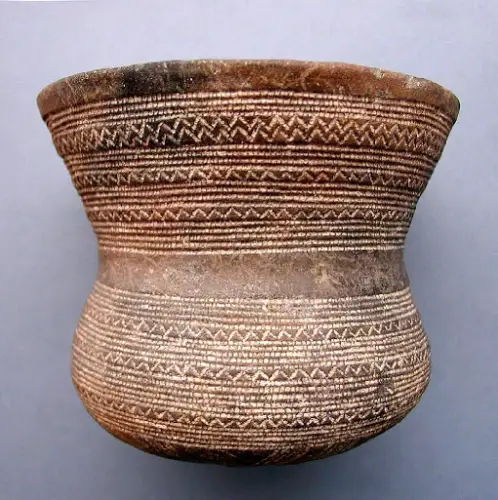
Inlay:
Decoration technique consisting of applying earth or materials like quartz, ground or stone to provide a distinct texture and appearance to the clay pieces.
K
Kaolin or porcelain:
The purest and finest type of clay, also known as “China clay”. This mass is nearly transparent white and is not very easy to handle, so it takes practice.
Kintsugi:
Kintsugi art is a Japanese technique that consists of using powdered metals, especially gold, to cover cracks in a ceramic piece. It is also used to join large broken items.
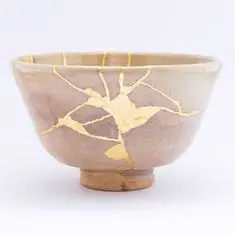
Taken from Pinterest
Kiln Furniture:
Kiln furniture is refractory material that is introduced into the kiln to load or serve as a support for the ceramic pieces. There are several types of kiln furniture that allow pieces to have an excellent firing and safety inside the kiln.
L
Lathing:
Lathing is the process by which the potter shapes the clay into a circle, using the potter’s wheel as a support.
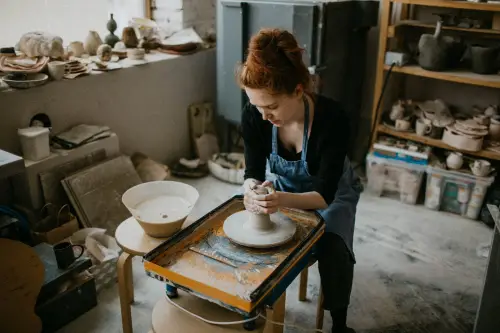
Lathe:
A machine turned by foot or motor that is used in pottery for modeling various clay figures. There are two types of potter’s wheel, the electric one, which is the most common, and the manual one, more complex to operate. This machine requires practice to achieve the expected results.
Lathe tools:
The lathing tools are those items used by the potter to model clay pieces. It makes this task much easier.
Lathed agate:
Decorative technique also known as veined agate. This technique consists of coloring a white mass, which will be turned with another color of your choice and therefore achieve a mixture of both colors.
Leather hardness:
State in which a clay piece, after modeled, has partially lost its humidity and has a leather-like plasticity, meaning that it is the perfect moment to carve it and make various designs with tools like ribbons and perforators.
Piece made with the Agate turned decoration technique
Pieces made with the turned agate technique.
Taken from issu
-Lusterware:
It is a type of ceramic known for its glazed decoration with metallic oxides that make the piece brighter, more elegant and in some cases, in natural light it gives the effect of color change.
This decoration technique is also known as metallic reflections, golden reflection, golden reflection Andalusian pottery, Malika opera or Hispano-Arabic reflection.
M
Marbling:
Decorative technique consisting of painting a ceramic piece to create the effect of marble. It is achieved by using up to 3 engobes that are applied to produce the impression of movement.
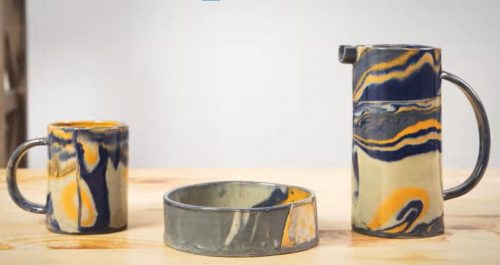
Masking:
Engobe handling technique that consists of leaving gaps in the natural color of the clay without engobe.
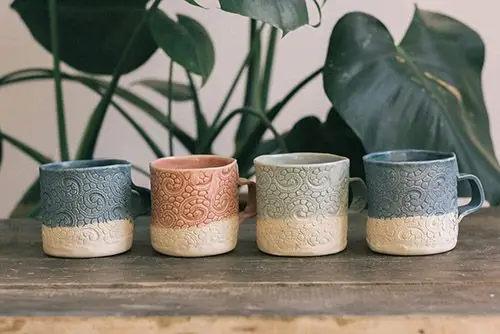
Taken from Domestika
In addition, such materials can easily burn at high temperatures, but once they burn out, their appearance changes giving the pieces a different appearance and texture, thanks to their properties when mixed with clay.
Mocca:
Decorative technique based on a mixture of water, tobacco or vinegar infusion and oxide. It is applied with a dropper, placing the ceramic base vertically so that the drop can form a tree or bush-like figure by itself.
Mold:
The mold is a hard, hollow cavity used in molding to produce clay pieces of identical size and thickness.
Molding:
Molding is a ceramic technique used to make distinct figures out of molds.
Modeling:
Technique to produce ceramics consisting of adding pieces of clay while forming a clay figure. Nowadays, there are several forms of modeling.
Monoprinting:
A decorative technique that attempts to transfer a design from a wet base to the clay.
N
Non-combustible materials:
Non-combustible materials in the ceramic world are those used to decorate clay objects by adding textures and finishes. Unlike combustible materials, non-combustible materials do not disappear or blend completely with the mass.
Some examples of non-combustible materials are glass, metals, sand and stones.
Novelty porcelain:
This is a type of ceramic typical of Japan which consists of making small imitations of figures of animals, people, objects and special occasions.
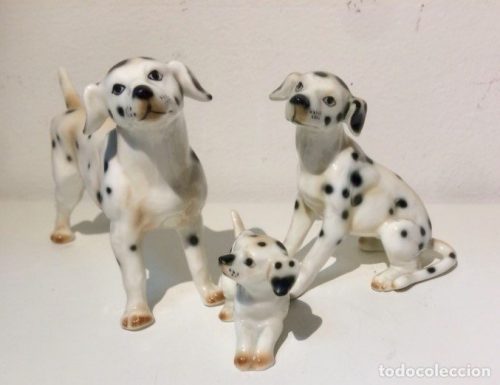
Taken from todocoleccion
O
On glaze:
A decoration technique performed over a layer of glaze that has been applied to the piece already. Usually, this layer is of a light tone such as white, which allows more colors to be added on top.
Openwork:
Decoration technique on ceramic figures consisting of making cuts, holes or perforations in different shapes.
P
Painting:
Engobe handling technique which is to paint freely with a brush and engobes the ceramic piece.
Pad printing machine:
This machine, as its name implies, prints designs on clay using a sheet of steel with the design engraved on it and a pad in silicone used to adhere the design and then print it on the piece.
Pastillage:
Decorative technique consisting of the addition of raw clay pieces of whatever shape and sizes the potter chooses to an already modeled piece of clay.
Perforator:
This tool is used to pierce the ceramic piece and trace shapes and stripes on the clay. It is used in leather hard clay, that is, when the clay has dried partially and before putting it in the kiln.
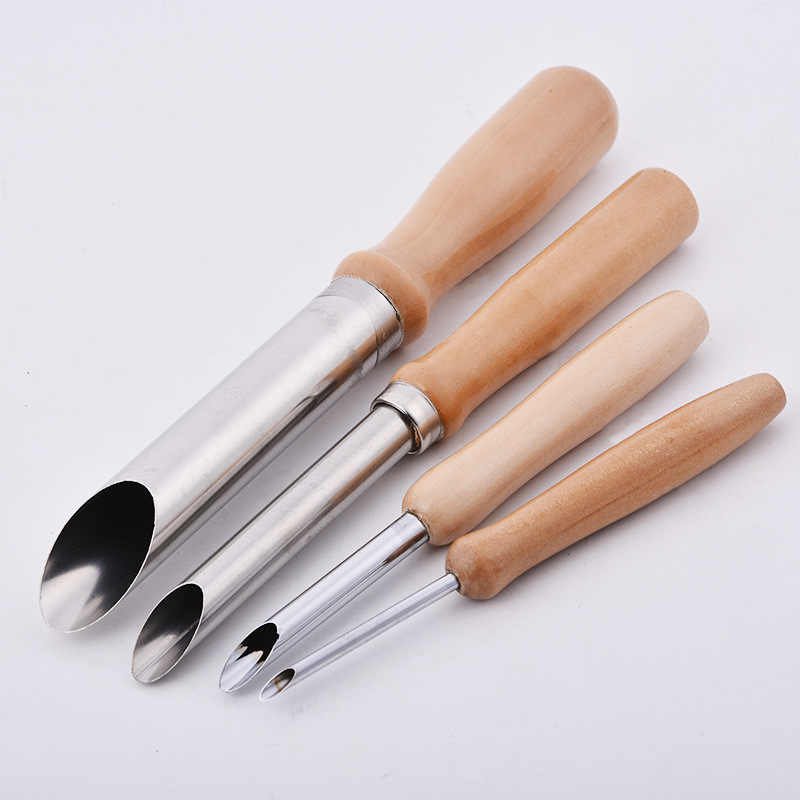
Taken from Aliexpress
Plasticity:
It is the feature of clay that allows it to be modeled retaining its shape without deforming at any moment.
Plate, platen, or wheel:
Part of the potter’s wheel that holds the clay to be modeled as it rotates. It can be a separate object from the potter’s wheel; it is exactly the same, having the same functionality, but can be moved back and forth with no need to carry the potter’s wheel.
Polymeric:
It is a type of clay made up of PVC, which makes it water resistant and easy to handle. Polymer clay is used to make several crafts.
Pouring:
It is an engobe handling technique consisting of pouring the engobe over the entire piece until it is completely covered.
Pottery:
Art, task or craft of making objects in clay or fired clay.
Potter:
A person who is dedicated to the craft of pottery.
This printing technique can also be done by using organic materials coming from nature such as linen, straw, cotton, among others; or by using inorganic materials such as cans, needles, glass, among others.
Powdering:
It is an engobe handling technique that consists of applying the engobe in powder form. Normally, powdering is used to provide clay objects with a distinct texture.
Pouring:
It is a technique of engobe handling consisting of turning the piece just after dipping it in the engobe to give it a blasting effect.
Printing:
Ancient decorative technique consisting of marking or pressing a pointed object, usually a punch, on the freshly modeled piece to leave a decorative sequence on it.
Q
Quartz:
Mineral temper that is found as precious stones or rocks. Its characteristic color is transparent white, very similar to a diamond, although sometimes it also has flashes of red, green, violet and blue.
Quimbaya ceramics:
It is a practice that owes its name to the tribe responsible for its creation, the Quimbaya Tribe during the year 500 BC.
R
Raku:
A type of clay composed of kaolin clay, refractory and ball clay. It originates from Korea and Japan, and it is widely used in Eastern countries, besides, it can be quickly fired and cooled.
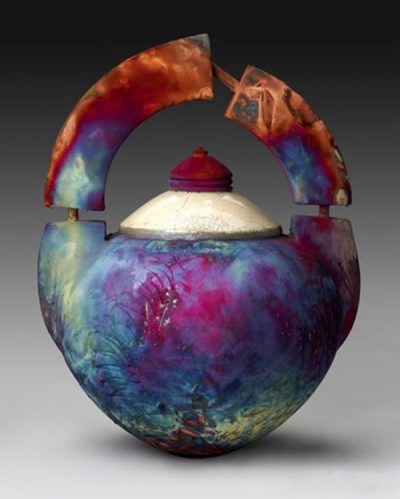
Taken from Guioteca.
Refractory:
Material that resists high temperatures caused by fire, therefore, artifacts made in this material do not deform or get destroyed.
Reserving:
Decorative technique consisting of changing the color of the clay during or after firing; the intention is to leave certain parts of the piece in the natural color of the clay.
If you want to know more about this technique we invite you to read our blog about ceramic decoration techniques after firing.
Ribbon tool:
It is one of the most used tools by professional potters and serves to make different designs by removing portions of clay that are no longer needed. Its tip comes in different sizes and shapes to achieve various
Rotary press:
This machine handles the modeling of the pieces by itself. The work is done by means of a header with a plaster or aluminum mold of the piece to be made, and a container on the base that holds the clay and helps molding.
S
Sand:
Type of temper used to harden the clay that will be used to make ceramic pieces.
Sanding:
Decorative technique that involves sanding the piece after firing to cause a worn effect on the outer walls or, on the contrary, to make them thinner and smoother.
Scraper:
It is a tool used almost always in the modeling process. The scraper, as its name says, scrapes the clay to shape the piece in a much simpler way.
Sgraffito:
Decoration technique that aims to expose the clay’s natural color in certain parts of the object. This is achieved by scraping a piece that has already been painted.
Silkscreen printing:
Decoration technique that consists of transferring an image to ceramic through the mesh of a frame.
Slab or plate:
This is a piece of clay that has been flattened with a roller or a roller machine. These plates work for making pieces with the slab modeling technique.
Smoke-firing:
Decorative technique whose purpose is to change a fired ceramic piece’s reddish color for a dark color such as brown or black. This technique is used to make Chamba pottery.
Stamps:
Stamps are a tool, and at the same time, are considered a decorative technique which main purpose is to press stamps that contain different shapes to transfer them to the ceramic piece. You can find stamps of different materials and decorative motifs in the market.
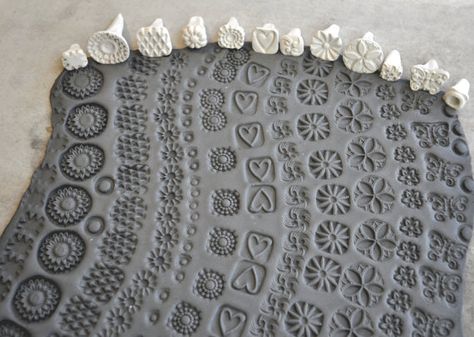
Taken from Pinterest
Stencil:
Decorative technique consisting of creating designs with materials such as paper and fabric.
Stringing:
Ancient decorative technique in which thin strings are pressed against the object to leave their marks as part of the object’s decoration.
Stoneware:
Clay composed of sand, minerals and other muds. It is hard, opaque and has no holes.
T
Tempering agents:
Tempers are those materials that are added to the clay so that it becomes less plasticized, in other words, to prevent it from deforming during all the processes to which it will be subjected.
Terracotta:
A red or yellow type of clay, though, after firing it can change to brown or pale pink. Terracotta clay is composed of magnesium, iron and alkaline earths.
U
Underglaze:
Decoration technique consisting of applying various colors on top of the bisque-fired piece, that is, after the piece has undergone firing and is still a little damp. After that, one adds a layer of transparent glaze or varnish to provide a shiny effect.
V
Varnish:
Transparent liquid substance applied on the raw clay to vitrify during firing and make the piece more resistant.
W
Wax:
Decoration technique using liquid beeswax to make sequences that will dry and stay as decoration on the piece.
Wari:
Wari pottery is a typical craft from Peru, specifically from the Huari or Wari culture.
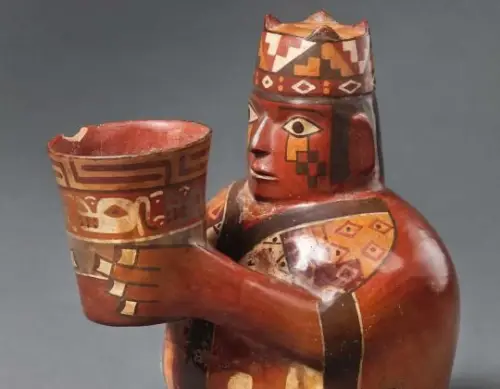
Taken from Pinterest
And so far we have reached the end of this glossary. What did you think? – We hope you have learned and that it has helped you so much that you will always turn to it whenever you have any doubts about the vast and fantastic world of ceramics.

